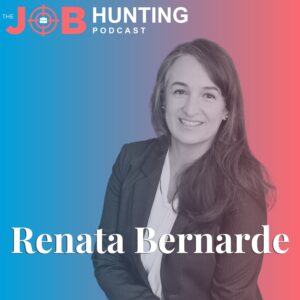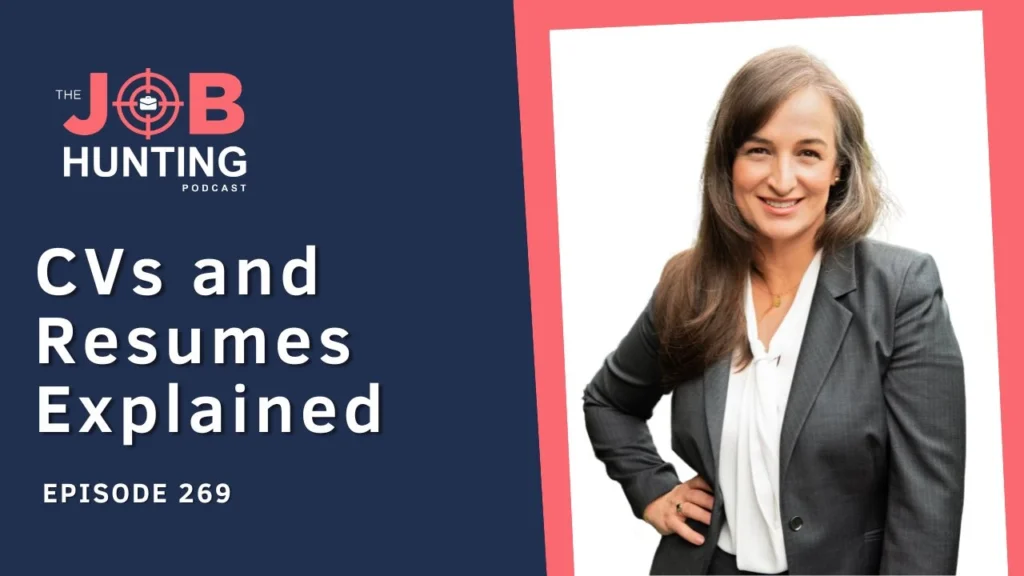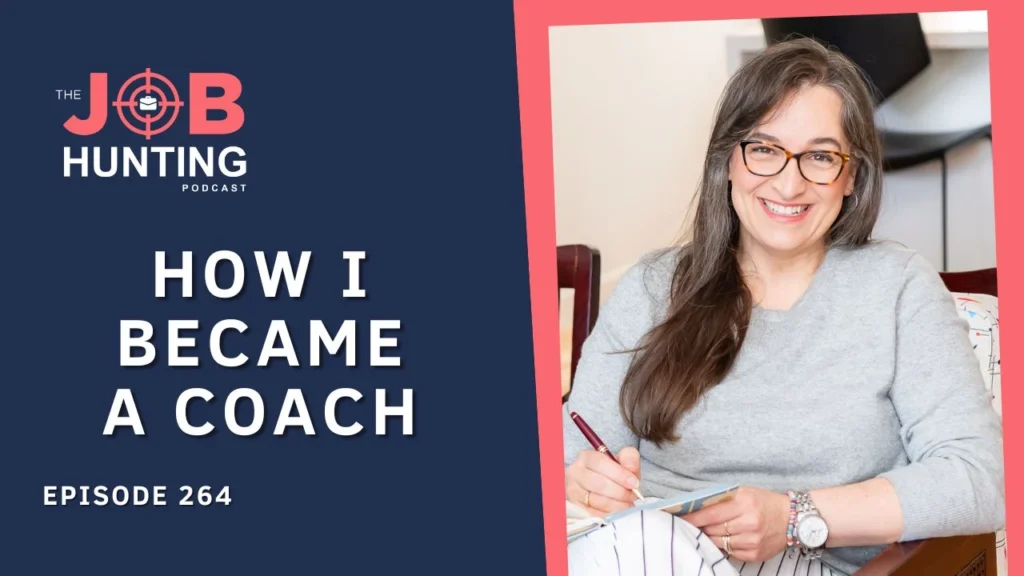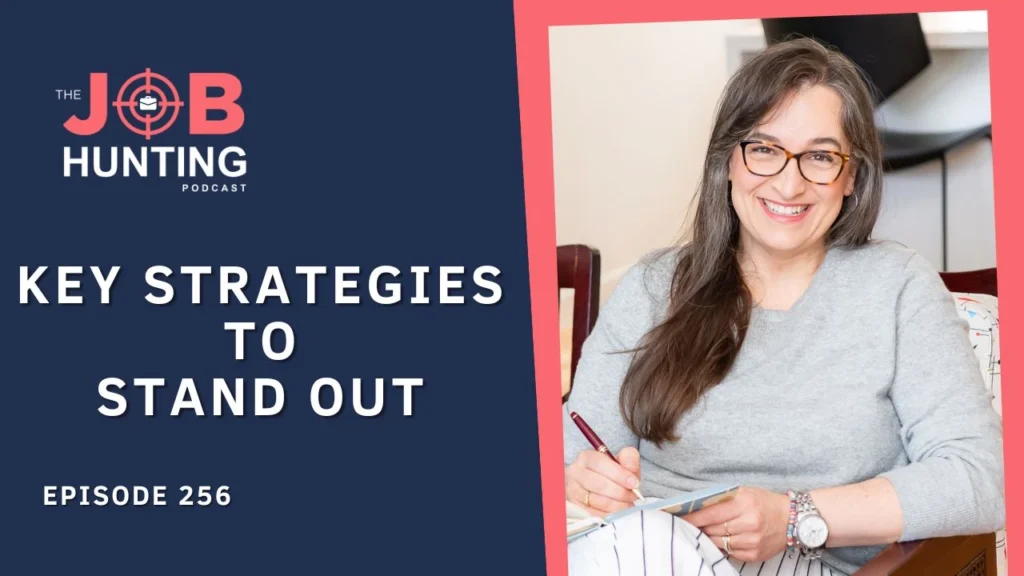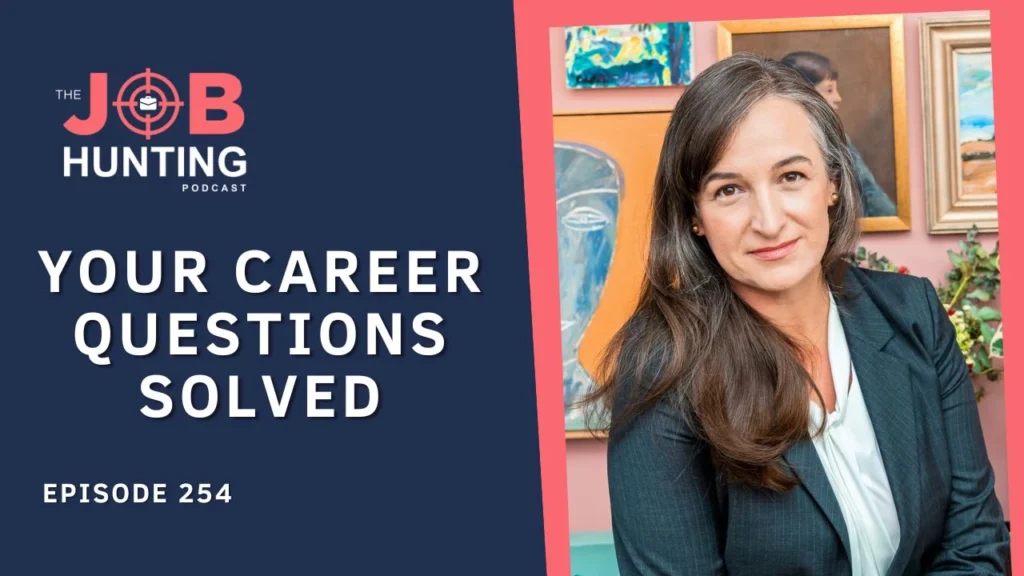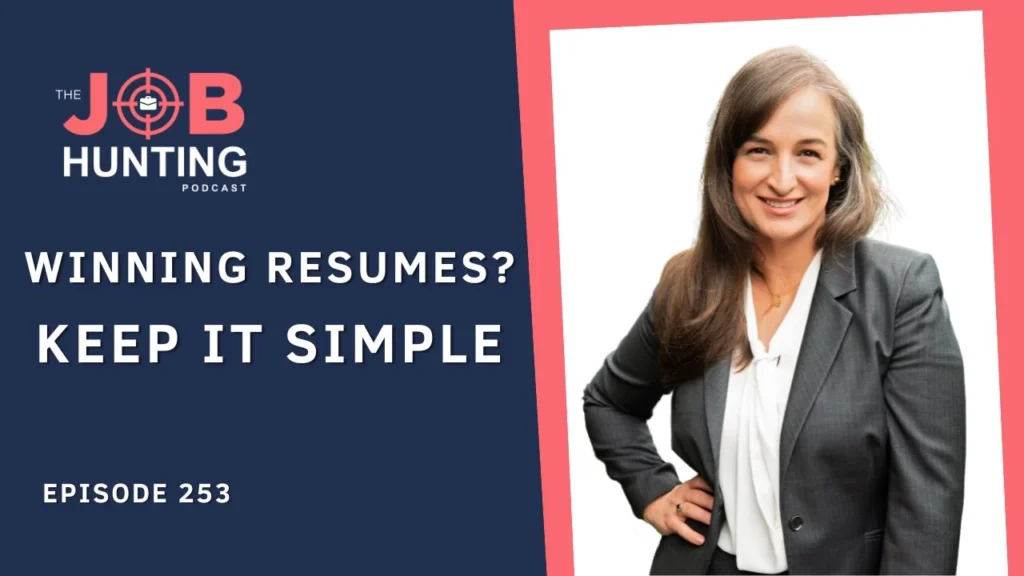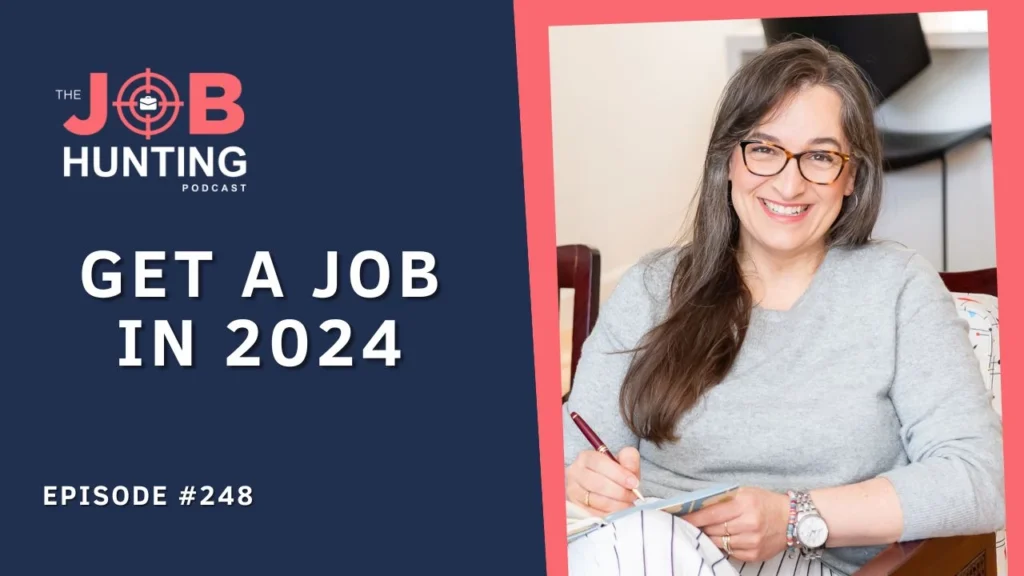I 100% believe that today in 2024, being honest is a very effective way of engaging with a recruiter and a hiring manager. Years ago, maybe not; back then, we needed to present ourselves differently. The executive presence expected then was different from the authenticity we expect now. In this episode, we will dive into the complexities of career transitions, and discuss challenges and strategies for executives and professionals. I’m Renata Bernardi, the host of the Job Hunting Podcast. Today, we’re exploring some of the most pressing questions our listeners have about navigating career changes and job searches.
As we enter 2024, I asked participants of my free job hunting masterclass if they had questions they wanted to ask me, which I could address during the masterclass. I asked them as soon as they registered, and it really allowed me to think about the slides and my presentation. We had over 300 registrations.
Many questions were submitted, and here is a sample that I believe will benefit everyone listening. Who are these professionals asking these questions? They are professionals in permanent or contract jobs in the corporate, non-profit, and government sectors.
If they are not currently working, they are seeking a job in one of these areas. They are usually mid-tier or executives with over 10 years of professional experience and may be getting stuck at some stage of the recruitment process, the selection process, or even in starting their job search.
These professionals are from all over the world. So, if you’ve attended the masterclass, you probably noticed from the chat that we had people from the U.S., Europe, the UK, and of course, Australia, where I’m based. This is also reflected in my coaching practice, where I have clients all over the world.
So, when did this Job Hunting Masterclass happen? Well, if you haven’t heard, it was on January 31, 2024, and I host at least one every year, sometimes twice. Last year, I only did it once. We had nearly 500 registrations last year, around 480 something. This year, we had fewer, about 300. I think the reason for fewer registrations was the timing. Last time I ran it in mid to late February, I believe. This time, it was at the end of January. Here in Australia, it’s summer, and that final week of January is when kids go back to school and people return to work.
So, I think I got my timing wrong. However, the reason I really wanted it to be during that week is because it is well-researched that it’s the most depressing week of the year. I don’t know if you’ve heard about that; from time to time, people write about it. It’s because you get all the bills from the festivities, you know, all the credit card bills start coming in, and it’s three weeks after your New Year’s resolutions, and you haven’t started them yet.
That’s why I wanted to do it at that time. I like that time. I think I’m going to stick with it, even if I had fewer registrations. I like to start the Job Hunting Made Simple group coaching in February. So, the masterclass usually marks the start of enrollment for the Job Hunting Made Simple program.
That is my signature program that I run. If you’re listening to this podcast when it comes out, enrollment will still be open. It closes on February 10, and you can go to my website to find out more. There’s a link in the episode show notes. At the end of this podcast episode, I will talk a little more about it.
So, I hope you stick around and listen, but let’s get started because we have quite a lot of questions, and I don’t want to delay it any longer for you. The first question we have is about transitioning to a remote role, which is a very popular topic. This question comes from someone working in biotech looking to transition to a fully remote role without relocating.
I actually have a client in that same position. So, let’s unpack this. First of all, regardless of what you want to do, if you’re looking to change roles, you want to leverage your professional network for sure. So, whether it’s remote or not, the importance of networking within your industry, in this case, biotech, cannot be overstated. I really suggest reaching out to former colleagues, mentors, industry contacts, and discussing your situation and what you’re trying to achieve. Trying to find a new job without opening up to a trusted network in confidence is really hard because that network is instrumental in supporting and advocating for you, maybe even referring you to opportunities.”
Then, I would like you to research and find out about companies that have remote work policies and culture. Some companies, even in the same industry, will have a very friendly, flexible approach to remote work, while others don’t. I suggest looking into companies that have a strong remote work ethos and have shifted to this way of working with their teams.
Next, look at remote work job boards and remote positions in biotech and related fields. This may sound obvious, but if you haven’t looked for jobs recently, you might not know that even on LinkedIn, under LinkedIn Jobs, there’s a search filter for remote opportunities.
You need to tick that filter and see what comes up. And, of course, if you want to be a remote worker, there are responsibilities that come with that. One of them is to enhance your digital presence. I need to stress the importance of having a strong online presence, especially on LinkedIn — one that is professional, crisp, and well-presented. Depending on your area of expertise, creating and updating a personal website might be beneficial. If you have a portfolio, you might want to showcase it in that way. Otherwise, LinkedIn can be a good way to create that portfolio within your profile as well, with features and links that you can add to each of your roles.
Another responsibility of a remote worker is enhancing your skills for remote work and enhancing your home office for remote work. Consider the essential skills required for remote work. They usually include self-motivation, excellent speaking, communication, and the proficient use of technology and online systems like Slack, Teams, or Microsoft SharePoint.
If you need to upskill in these areas, now is the time. The same applies to your office technology — your Wi-Fi, computer, monitors, cameras, and so forth. Then, interview preparation for remote work will have to showcase that you can represent the company well from home. Focusing on this specific type of interview preparation is important.
Finally, I’d like to ask the listener to consider ways of engaging with remote work that are not permanent roles, like consultancy and freelance. We have some episodes of the podcast about this. I’m going to add a link here. As you can imagine, this episode is being recorded very last minute. But I want to include a link to a specific episode with the founder of Workling about the gig economy and working as an executive freelancer, which I think is a different type of freelancing that people are not very aware of yet, but it’s coming, it’s trending, and it’s important for you to know.
Okay. So that was the first question.
Let’s look into a second question, which is about presenting past leadership experience. This question comes from a solo parent who paused their executive career and is now looking to reenter that space. That person has kept working in senior roles, but I’m assuming that from a very ambitious, fast lane, they shifted to a slower lane, which is very common during the period when you’re raising kids, especially if you’re a solo parent.
And now you want to go back into the fast lane again. That’s very common. I went through that, and I know many people have as well. So, how can they present their past leadership experience as still relevant? Well, first of all, we need to consider if it is still relevant.
We need to be pragmatic. We need to consider upskilling. Considering how much things have changed recently, even if you have been in that fast lane, upskilling is really important for senior executives. The things I was talking about before regarding a remote workforce really apply to leaders who want to be high-performing and have high-performing teams with strategies that roll out in a way that is so different from five years ago. So that is important. And also the executive presence that is now required. I mean, if you watched the masterclass, as I believe this person did, we have discussed the different trends in showcasing executive presence in 2024 versus what was trending five years ago.
But here are some key points you need to address to consider making that move towards the fast lane again. I’m all for it. So, first of all, it’s, of course, highlighting the transferable skills. And I know that this is very basic, but I still need to say it. You need to identify and emphasize your transferable skills that you acquired over these past years, such as strategic thinking, leadership, problem-solving, cross-cultural communication — all the important skills.
Key skills for senior executives. Then include examples of these skills and how they were applied in different contexts over your career. Next, reframe the career gap. It’s not really a career gap because you have continued working, but frame it positively and normalize it as a common experience many professionals go through when raising a family.
Also, view the solo parenting experience as an asset. We discussed this in the free masterclass about the need to engage with your leadership, your authentic self, and your roots, and demonstrate that as you pitch yourself and go through job interviews. Leverage your professional networks and really finesse and refine your pitch so that they can understand the level of ambition you have now and the different stage you are in your career that allows you to go back into the fast lane. Craft a strong brand that speaks to the roles you want to apply for—a compelling narrative that reflects your strengths, experiences, and readiness for those big roles. Again, I think your LinkedIn profile really needs to reflect that. So, you might need to go back and redo it, considering the stage you are in now in your career. All of your application materials need to be updated and tailored to identify what you want to do and then reflect that, creating a new, cohesive narrative that needs to be worked on when you’re approaching recruiters and applying for roles. It’s important for them to understand why you’re applying for them. And I guess that’s where I’ll stop, because there are just so many other things you can do. And, working with a coach can be very helpful. But let’s summarize the points: highlight your transferable skills, reframe your career gap, update your industry knowledge, leverage your professional network to support and mentor you, and advocate for you with that story about this next stage of your career and that you’re ready for it. Then, craft that strong brand. Good luck. Working with me might be an interesting partnership.
Okay, we have another question, and it’s about finding a consistent pathway for a career change.
So, this third question is about finding a consistent method or pathway for a career change and what the key steps are. Oh boy, I have a whole framework to coach you, but in a nutshell, the first thing you need to do if you want to make a career change is thorough research. Thorough research is really important because you might be dreaming about a new industry or a new role, but you need to understand the skills, qualifications, and experience required for that next career. And, you know, module two of my program, Job Hunting Made Simple, is all about the different pathways to get there. It’s a complex conversation, but I’m trying to summarize it here for you. Then, building a strong professional network in this new career path you want to transition into is essential, as it provides expert advice and potential opportunities in this new field.
Of course, upskilling may not always be necessary. I won’t automatically advocate for you to spend money on it. But some professions, like being a financial advisor in Australia, require specific certification. If you want to be an accountant, there is professional development you need to undertake. However, other career transitions might not require such investment. So, be pragmatic about the level of investment and the steps you need to take to enable that change. Then, gain experience by seeking opportunities to get practical experience, even shadowing people in this new career path, volunteering, and finding roles that allow you to transfer some of your skills, and then tailor your applications.
Of course, you will need to customize your resume to ensure that the experience you’re bringing from your past into this new path is highly valuable. It’s essential to highlight your transferable skills because, as an experienced professional contemplating a career change, you shouldn’t disregard all the relevant experience you have already acquired. Find ways to educate your new industry, sector, or path on how important all of those experiences are and how they can benefit this new organization and the new path you’re carving for yourself.
So, there you go: research, network, upskill, gain experience, and tailor your applications.
And then, a question I get asked a lot every time I do a masterclass like this is about addressing ATS in resumes. This time, the question was a bit more creative because it also mentioned LinkedIn profiles.
Understand that there are algorithms that will read your resume and your LinkedIn profile. For Applicant Tracking Systems, once you upload your resume into a job application online, it will be screened by software before it’s screened by a person.
And LinkedIn as well. It’s not just about looking good for your friends, family, and colleagues; it needs to be well-written for searchability so that recruiters and HR departments can find you when they’re looking for professionals.
Optimized resumes and LinkedIn profiles not only help you get interviews from your job applications, but they also help you be approached by recruiters for roles, instead of you having to apply for them. So, you’re jumping the queue there if you have a good LinkedIn profile.
The first thing you need to do is analyze job descriptions. Work backwards from the job descriptions that interest you, regularly looking at job ads in your field, and identifying common keywords and phrases. For example, I was with a client this morning asking him to refine his narrative to align more with recruiters’ jargon. This is a sign of someone trying to change sectors, countries, industries, or even someone who hasn’t applied for a job in a long time and may not be aware that the language has evolved. It’s like when I go back to Brazil after being away for a couple of years; I find that the way people talk has changed. The same thing happens in recruitment.
Then, simplify your formatting. This is so important. Avoid complex designs or visual elements in your resume. No tables, no graphics. Use clean, straightforward formatting that’s easy to read by software. I’ve been saying this since the beginning of this podcast, over four years ago, and I still often receive resumes from clients that haven’t followed this advice. So, please, get rid of all those tables and graphics.
If you need help updating your resume, I would be more than happy to assist, as my resumes get a lot of traction and conversions. What are conversions? Conversions are when you apply for a job and you get an interview or a call. That’s the first goal of a resume: not to get you a job, but to get you an interview.
My format is very effective for that, and you can get it inside my program. I will help you customize and tailor it to your specific needs, as I do with all my clients in both group coaching and private sessions. Customizing content is key. Tailoring your resume to each specific application is essential to align your application with what HR systems are designed to do. Recruiters and HR professionals use these systems to input specific keywords, skills, and experiences they’re looking to find in the resumes submitted for a job. So, tailoring your resume is crucial. It might sound like a lot of work, but we have a method in my coaching that simplifies the process of continuously tailoring it every time.
I’d be delighted to share this method with you. Engaging on LinkedIn is also vital. LinkedIn must be used actively; it’s not a set-and-forget tool. You need to demonstrate your expertise, include keywords and skills, write an engaging about section, have a great headline, and use a professional photo. All of these elements are important for your profile to be found by the right recruiters looking for candidates like you. So, yes, understand ATS, remember keywords are important, optimize your formatting for both human eyes and bots, and use LinkedIn regularly.
Question number five: evaluating worth and requesting a pay rise. This question is from a professional who is taking on more responsibilities at work and wants to know their worth for a potential pay rise.
This is very common; people often start piling up more tasks and responsibilities without offering a pay rise. When considering your worth at work and asking for a pay rise, start with research and preparation. Research the market value of your position. Some organizations, especially in government and non-profits, and sometimes even large enterprises, have well-publicized structures with salary ranges. This will give you a solid foundation to support your request and ensure it’s reasonable.
You can also use online forums like Glassdoor, but talking to colleagues and friends about salaries is also beneficial. We need to be more open about salaries; the idea that it’s impolite to discuss salary only serves employers, not employees. Reflect on your recent responsibilities. If you’ve been given tasks above and beyond your job description, especially with new responsibilities, you have a stronger argument for a pay increase.
Consider a realistic salary range you would accept, entering negotiations with a clear goal. Be prepared to negotiate, possibly combining salary with other benefits, bonuses, or equity, especially in startup environments. Timing is also crucial; be aware of company financial cycles and potential stress periods. Articulate your value during the negotiation. Sometimes it’s not so much about an increase as it is about a salary update. If you find out you’re being paid less than your colleagues, that’s another angle for negotiation.
Sorry, my energy is a bit low; it’s Friday afternoon as I record this. But the gist is to consider the timing of your request, be flexible, and learn to articulate your value effectively.
So, it’s not so much an increase, but more about wanting to be at par with your colleagues. This is very common, especially in organizations with different contractors doing similar jobs but earning differently due to varied tenders with contractors. It’s a bit messed up, I know. So do your research, talk to people, reflect on your contributions, decide on a target salary range that you’re comfortable with, and be mindful of the timing. Good luck, and I hope it works out for you.
Question number six: Let’s address a gap in your resume.
Addressing gaps in a resume is a common question and can be tricky. Although this specific question is about a 12-month gap, which is considered longer, I don’t get too concerned about a three-month gap. I don’t think most good recruiters would. There could be valid reasons for taking a break between jobs. When addressing a longer term gap in your resume, it requires an honest and straightforward approach. Here are some tips:
Firstly, be honest. I was speaking earlier today, on this Friday, the 2nd of February, with someone who planned a break for travel but ended up caring for sick family members. It’s common to have a break for good reasons like travel or for necessary ones like caring for family or dealing with personal health issues. I believe that in 2024, honesty is a very good way of engaging with a recruiter and a hiring manager. The expectation of authenticity is different now compared to the past.
Whether your break was for personal reasons, study, travel, unemployment, or burnout, honesty is the best policy. Then, focus on the positives. During your gap, you may have gained skills, wisdom, and experience. It’s important to mention what you were doing, whether it was participating in an activity, resting, traveling, or volunteering. Explain how the gap has contributed to your personal and professional growth. If there wasn’t professional growth, perhaps you had time to reflect and now know what you want, which makes you a better candidate for the job.
Keep your explanation brief. People tend to overexplain when they feel uncomfortable about something. Be concise in your response, whether in a call, interview, cover letter, or LinkedIn’s ‘About’ section. Avoid over elaborating or making excuses. Maintain a professional tone when discussing the gap, and focus on the future, what you want next, and how you’re ready to contribute to a new organization and role.
Career gaps are more common than people think. Employers and recruiters are generally understanding, as they often talk to candidates who are returning to the workforce after a break. Whether it’s a short or long break, this could be a new experience for you, but it’s a familiar one in the job market.
It’s not a new experience for the recruiter or the employer. So, be honest, focus on the positives, explain the benefits of taking the break, keep it very brief, and stay professional. That’s a good summary.
Alright, next question, question number seven: CV format. Is it Word or PDF? I made a joke about Canva and was serious about that, but let’s talk about Word or PDF. Most of my clients, who are corporate professionals, have a Word resume or CV that they then convert to PDF and send out.
There are times when the instructions ask for a Word document. This happens because of the ATS software that the organization uses, which prefers reading a Word document. The first thing I’m going to say to this person, and to you if you’re curious about this, is to follow the instructions. The instructions will most likely be there somewhere, either in the LinkedIn job ad you found, on Indeed, or wherever you found it. But go above and beyond and look at the company career page for thorough instructions. Many companies do provide detailed instructions there.
When I’m teaching and coaching, I show my clients the importance of following these instructions. Large consulting companies and banks, for example, usually have very detailed instructions on the careers page of their website.
The choice between a Microsoft Word or a PDF format for your resume or CV depends on compatibility. PDFs are usually readable by ATS systems and maintain their formatting well if you keep it simple, as I’ve explained before. Some ATS systems handle Word documents better, which is why you sometimes see a preference for Word in job applications.
Word documents can be easily edited, so you should always have a master document in Word, then convert it to PDF just before sending it out for a specific job. That’s pretty much it. I hope this helps. Of course, I have specific templates that I like. I have templates for a more American style resume and for Australia, UK which is a bit longer. If you want to have access to that, you’ll need to work with me, and I’d love to do so.
Question number eight is about the duration of the job search, specifically for senior roles. It’s good that it’s specific for senior roles because it will be different from the average job search duration usually published by government departments, which is around 12 to 13 weeks on average. But there’s a wide range of jobs, and typically, clerical jobs and junior roles, for example in retail and hospitality, will be quicker to obtain on average.
If you’re at the top of the pyramid, remember, the pyramid narrows at the top. There are fewer roles, and turnover is not as high. Finding a senior role that is a good fit can vary in duration but is usually longer than the average 12 weeks.
For very well-prepared candidates — those who are crisp and clear, have a great pitch, an effective resume, a well-performing LinkedIn profile, and strong interview skills — the job search can last a minimum of four months. However, it’s not uncommon for these searches to extend over a year. Factors influencing the duration can include the time of year (starting a search in late November, or during the summer in the U.S.), and the demand in your region. Geography plays a role as well.
Your experience and salary expectations, as previously mentioned, also play a role. The strength of your professional network is crucial; if you have a network that can vouch for and support you, especially if you are looking to make significant changes. For example, I have a client who could have already found a job in his current sector, but he wants to change sectors. He’s doing well in terms of getting interviews and reaching the latter stages of recruitment processes, but it’s taking longer due to the magnitude of the change.
He understands that working with me has been beneficial, but acknowledges that it will take extra time to adapt to the new sector, build a network, and explain to recruiters his reasons for changing. All of these factors affect the duration of his job search.
I can help you with your job search skills. If that’s what’s hindering you, that’s where I come in. My goal is to reduce your search time and help in ways you might not have considered, addressing not just your immediate needs but your long-term career plans as well. For senior-level executives, especially those at the C-level, it’s typical to spend between six to 12 months in an active job search.
I recently started working with a C-level client on a 12-month retainer. She’s currently employed and plans to slowly tap into her network to make a stress-free transition. This is also a possibility for you. To enhance your job search, consider the quality and quantity of your professional network, your salary requirements, where you want to work, and the current market conditions. The market at the beginning of 2024 is sluggish, so keep that in mind.
Being patient and persistent is crucial, and having a well-thought-out job search strategy is key to finding a senior role that’s a good fit for you.
I think I’m going to stop at this next one. We’ve already gone for 43 minutes! I have more questions ready, but I didn’t realize how long this would take. I’ll have to record another episode at another time. But, here is question number nine, the last one for today: Balancing authenticity and self-promotion in interviews.
Striking the right balance between being authentic and selling yourself in job interviews is challenging. It requires sophistication and practice. The key is to maintain a balance between being genuine and presenting your best self. You are there to present yourself at your best, but they also want to know that you are a real person. It’s about showing your strengths and acknowledging areas of growth. I recall discussing with a client in the U.S. about an interview they had with a high-profile headhunting company.
They asked him about his areas of growth and what he was working on in terms of personal development. He thought it was right to say he was fine, but that wasn’t the right approach. The better response would have been to acknowledge the areas that have tripped him up in the past and to discuss how he’s currently addressing them and planning to improve his leadership style or his performance as a team leader, project manager, or financial controller, or whatever his role may be. It’s important to be genuine about the areas of growth you’re still working on.
My tips are to first embrace vulnerability. This is something new and wasn’t expected of executives in the past, but sharing moments of vulnerability, where appropriate, is okay now. Discussing challenges you’ve faced before and how you’ve overcome them shows authenticity and allows you to make more meaningful connections with your interviewers. This is now a necessary part of job hunting.
Another tip is to practice authenticity. Under stress, it can be hard to let your true self shine. When anxious about a job interview or talking to a recruiter, we tend to enter fight or flight mode. Practicing your responses is crucial, and working with a coach can help, as they can create challenging scenarios for you. This preparation can be beneficial in interviews, as it helps you handle stress better.
Discussing areas of growth genuinely and making connections is important, especially for senior executives, since the recruitment process can be lengthy and involve interactions with multiple people over weeks or months. Being a confident communicator, avoiding awkwardness, and being well-prepared is key. Being prepared doesn’t just mean getting ready for a specific interview; it means being prepared at all times. In my program, Job Hunting Made Simple, we do a lot of this preparatory work upfront, so you’re ready even for short-notice interviews.
In summary, embrace vulnerability, practice authenticity, be candid, foster genuine connections, and be confident in your communication and storytelling.
I hope these answers help you and those who asked these questions. Thank you for sending them in; they are very insightful. Some of these questions might become an entire episode because they require more in-depth discussion. I wanted to share these questions at the beginning of the year to encourage you to send more if you have them, especially within the Job Hunting Made Simple program.
If this episode motivates you to work with me to get to your next job or career stage faster, then consider enrolling in Job Hunting Made Simple. You can find it on my website. This online course and coaching program is tailor-made for professionals like you and is designed to transform your career journey. It’s a unique program, born from my head and based on over a decade of practical insights from my career and from helping my clients.
Corrected Transcript:
My journey with this began when I was crafting what turned out to be a winning strategy for my own career advancement, an award-winning strategy when I was an MBA career manager. Today, I’ve adapted this program for my clients and have tested it very successfully with many professionals so far.
Since 2024, I’ve reached the point where I’m offering the Job Hunting Made Simple program in three different options. The first option is the online course, which includes seven modules delivered weekly for seven weeks. Once delivered, it’s yours for life. It’s a self-guided, budget-friendly approach that you can return to whenever you want.
The second option, which I recommend, is the online course plus seven weeks of group coaching, starting in February. Last year, I only offered it once, and I’m not sure about my availability for the rest of 2024 due to other commitments like outplacement or HR consulting. The group coaching involves a community environment with like-minded professionals from various countries, including the U.S. and the U.K., and features bonus speakers in addition to myself. We meet for our weekly sessions twice a week.
The third option, with limited capacity, is private coaching with me, also following the seven-module framework from Job Hunting Made Simple. This is suitable for those who need to keep their job search confidential due to contractual clauses or specific learning requirements where one-on-one coaching would be more beneficial.
I want you to consider these three options and remember that enrollment is closing on the 10th of February, with the program starting on the 13th of February. I won’t be running it again before August at the earliest due to other commitments. This program is designed for seasoned professionals seeking their next big job opportunity, a promotion, or a career redesign.
If you’re interested, I’d love for you to join me. Let’s work together to turn your career goals into reality. You can find more information my website. That’s all for this episode. Thank you so much; it was a long one. I look forward to seeing you either inside the group coaching or in the next episode.
Goodbye for now. Bye.

